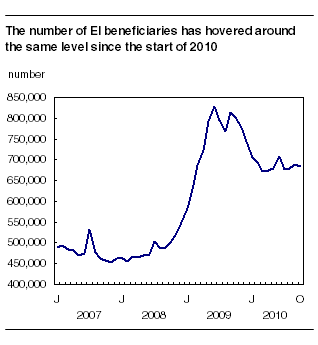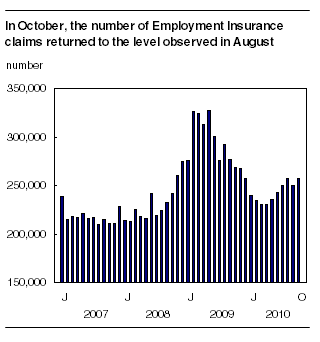Employment Insurance
Archived Content
Information identified as archived is provided for reference, research or recordkeeping purposes. It is not subject to the Government of Canada Web Standards and has not been altered or updated since it was archived. Please "contact us" to request a format other than those available.
Related subjects
-
[an error occurred while processing this directive]
The number of people receiving regular Employment Insurance (EI) benefits edged down by 5,200 in October to 683,300.

Compared with the most recent low in March 2010, the number of beneficiaries edged up 1.5% or by 10,400.
Higher number of claims
To receive EI benefits, individuals must first submit a claim. In October, 257,700 initial and renewal claims were received, up 7,500 from September. This increase offset a similar decline the previous month. From April to August, the number of claims had been trending up by an average of 6,800 per month.
Note to readers
All data in this release are seasonally adjusted unless otherwise specified.
Each month, Statistics Canada provides analysis of the current labour market situation, using Employment Insurance (EI) statistics and other sources. Earlier this November, the Labour Force Survey (LFS) provided a picture of overall labour market conditions, including unemployment, total employment and those affected by changes in the labour market.
In this release, Statistics Canada provides additional sub-provincial detail through the EI statistics. Details by industry will follow with data from the Survey of Employment, Payrolls and Hours.
EI statistics are produced from an administrative data source from Human Resources and Skills Development Canada. These statistics may, from time to time, be affected by changes to the Employment Insurance Act or administrative procedures. The number of regular beneficiaries and the number of claims received for September and October 2010 are preliminary. In this release, large centres correspond to those with a population of 10,000 or more.
The number of beneficiaries is a measure of all persons who received EI benefits from the 10th to the 16th of October. This period coincides with the reference week of the LFS.
EI statistics indicate the number of people who received EI benefits, and should not be confused with data coming from the LFS, which provides information on the total number of unemployed people.
There are always a certain proportion of unemployed people who do not qualify for benefits. Some unemployed people have not contributed to the program because they have not worked in the past 12 months or their employment is not insured. Other unemployed people have contributed to the program but do not meet the eligibility criteria, such as workers who left their job voluntarily or those who did not accumulate enough hours of work to receive benefits.
The change in the number of regular EI beneficiaries reflects various situations, including people becoming beneficiaries, people going back to work, and people exhausting their regular benefits.
The increases in October occurred mainly in Quebec, Alberta and British Columbia. The number of claims provides an indication of the number of people who could become beneficiaries.

Provinces: Little change in beneficiaries
Changes in the number of regular beneficiaries in October were minor in all provinces.
Compared with the most recent low in March 2010, the number of beneficiaries increased by at least 3% in Nova Scotia (+4.2%), Manitoba (+3.4%), Quebec (+3.2%) and Ontario (+3.2%).
Over the same period, Alberta (-9.8%) was the only province to record a decrease in beneficiaries.
Sub-provincial and demographic overview
Employment Insurance data by sub-provincial region, sex and age are not seasonally adjusted. Therefore, they are compared on a year-over-year basis.
Most large centres showed year-over-year declines in beneficiaries
Between October 2009 and October 2010, the number of regular beneficiaries fell in 119 of the 143 large centres (see map). The number of large centres reporting declines has been relatively stable in the last seven months. Large centres are those with a population of 10,000 or more.
In Newfoundland and Labrador, the number of beneficiaries rose in one of the five large centres, Corner Brook. This was the first increase for Corner Brook in eight months. In St. John's, the number fell by 540 to 4,100, the seventh consecutive month of year-over-year declines. The fastest rate of decrease occurred in Labrador City, which registered fewer beneficiaries in all 10 months of 2010 on a year-over-year basis.
In Quebec, the number of regular beneficiaries fell in 28 of the 33 large centres between October 2009 and October 2010. The fastest declines occurred in La Tuque, Matane, Granby, Thetford Mines, Dolbeau-Mistassini and Sorel-Tracy. Montréal recorded 4,100 fewer beneficiaries in October, the eighth consecutive month of year-over-year declines. In the census metropolitan area of Québec, the number of beneficiaries rose by 520, the fifth consecutive increase.
In Ontario, 37 of the 41 large centres posted a decrease between October 2009 and October 2010. The most notable declines were in Greater Sudbury, Chatham-Kent, Tilsonburg, Norfolk and Woodstock. In Toronto, 67,400 people received benefits in October, down 15,500 from 12 months earlier. This was the eighth consecutive month of year-over-year declines.
All 12 large centres in Alberta had fewer beneficiaries in October compared with October 2009. The pace of decline was fastest in Brooks, Camrose, Red Deer, Grande Prairie and Medicine Hat. For the seventh consecutive month, there were fewer beneficiaries in Calgary and Edmonton. In Calgary, the number of beneficiaries fell by 6,900 to 11,600. In Edmonton, the number declined by 3,600 to 11,300.
In British Columbia, the number of beneficiaries fell in 21 of the 25 large centres in the 12 months to October. The fastest declines were in Fort St. John, Cranbrook, Port Alberni, Prince George and Dawson Creek. In Victoria, the number of beneficiaries declined for the seventh consecutive month, down 600 to 3,200. In Vancouver, it fell by 2,500 to 28,700, the fifth decline in a row.
Demographic groups
Faster decline in the number of beneficiaries among men than women
Between October 2009 and October 2010, the number of male EI regular beneficiaries fell by 67,100 (-18.4%) to 297,100. This was the eighth consecutive month with a year-over-year decline.
For men, the fastest rates of decline occurred among those aged 15 to 24 (-27.3%) and 25 to 54 (-21.1%). Over the same period, the number of beneficiaries edged down by 2.3% for men aged 55 and over.
The rate of decline was slower among female beneficiaries. The number of women receiving regular benefits decreased by 9,400 (-4.1%) to 223,200 during this year-long period. This was the fifth consecutive month of decline.
For women, the number of beneficiaries decreased by 3,100 (-16.1%) among those aged 15 to 24, and by 11,100 (-6.4%) among those aged 25 to 54. In contrast, the number of female beneficiaries aged 55 and over increased by 4,700 (+11.5%).
Available on CANSIM: tables 276-0001 to 276-0006, 276-0009, 276-0011, 276-0015 and 276-0016.
Definitions, data sources and methods: survey number 2604.
Data tables are also now available online. From the Key resource module of our website under Summary tables, choose Subject then Labour.
Employment Insurance data for November 2010 will be released on January 20, 2011.
A set of maps, Employment Insurance Statistics Maps, October 2010 (73-002-X, free), is now available online. The maps show percent changes in the number of people receiving regular EI benefits for all census metropolitan areas and census agglomerations in Canada. From the Key resource module of our website, under Publications, choose All subjects, then Labour.
For more information, or to order data, contact Client Services (toll-free 1-866-873-8788; 613-951-4090; labour@statcan.gc.ca). To enquire about the concepts, methods or data quality of this release, contact Kevin Forneris (613-951-8235) or Vincent Ferrao (613-951-4750), Labour Statistics Division.
- Date modified:
